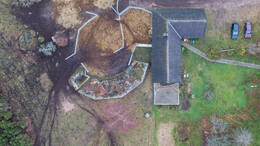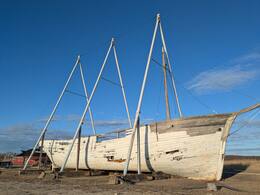Kaip vokiečiai gaudavo šviežios kiaulienos užkariaujant Hiumą
Sõru 1917
1917 m. spalį, per Antrąjį pasaulinį karą, Vokietija per drąsią jūrų operaciją „Albion“ užėmė Vakarų Estijos salas. Carinė Rusija daugelį metų aplink Taliną ir salose buvo statiusi milžinišką įtvirtinimų sistemą – Petro Didžiojo jūrų tvirtovę, kuri, deja, chaotiškomis 1917 m. sąlygomis negalėjo įvykdyti savo misijos. Kaip žinoma, artileristai taip pat reikalingi artileristų ugniai užtikrinti, tačiau kai jie praranda apetitą karui, net ugnies klubai nutyla. Tačiau vienas iš nedaugelio dalinių, apsikeitusių ugnimi su vokiečiais, buvo 120 mm pakrantės baterija „Sõru“. Vokiečių karo laivas „Bayern“ – didžiausias karo laivas, kada nors kovojęs Estijos vandenyse – buvo atsitrenkęs į miną, bet vis dar buvo pajėgus kovoti ir kartu su kreiserio „Emden“ patrankų ugnimi privertė bateriją nutilti, o įgulą bėgti. Tuomet vokiečių minų traleriai įplaukė į Soelos sąsiaurį, kad išvalytų jūrų minų kelią. Tuo pačiu metu „Sõru“ artilerija grįžo prie savo baterijų ir vėl atidengė ugnį į priešo laivus. Dabar vokiečiai į paplūdimį pasiuntė desantą, kuris sunaikino patrankas. Taip pat buvo rekvizuoti keli kiaulės, kad būtų sustiprinta šviežios mėsos kovinė dvasia. Kelias į Väinamerri buvo laisvas. Per kelias dienas buvo užkariauta visa Hyjuma, o Rusijos kariuomenė neparodė jokio pastebimo pasipriešinimo vokiečiams.
Daugiau skaitykite: https://teejuht.esap.ee/eesti-ringreis/esimese-maailmasoja-operatsiooni-albion-merelahingud-soela-vainas-ja-vainamerel/
Susijusios vietos
Hindu (Seru) 120 mm pakrantės apsaugos baterija Nr. 34
Baterijos statyba pradėta 1914 m. Kadangi tai buvo papildoma baterija, jos trūko pradiniame jūrų tvirtovės plane, o pabūklų tipas buvo ne kartą keičiamas. Galiausiai buvo sumontuoti keturi 120 mm „Vickers“ pabūklai. Pabūklų vietoms ginti buvo supilta 200 m ilgio ir 10–20 m pločio seklumos, kuri virš pabūklų buvo užbetonuota. „Hindu“ buvo vienintelė baterija Hijuma saloje, dalyvavusi koviniuose veiksmuose per Tagalahe išsilaipinimą 1917 m. spalio 12 d. Po trumpo susišaudymo su vokiečių karo laivais rusų artileristai pabėgo, palikdami bateriją nepažeistą. Vokiečiai pasiuntė į sausumą kareivių desanto būrį, kuris susprogdino baterijos pabūklus. Vienas iš vokiečių karo laivų, apšaudžiusių hinduistų bateriją, buvo „Bayern“ – didžiausio kada nors Estijos vandenyse buvusio karo laivo vandentalpa (ilgis 180 m, vandentalpa 32 200 tonų, aštuonios 380 mm pabūklai). Baterijos radijo stoties pastatas buvo perkeltas į Emmastę ir panaudotas kaip bendruomenės centras (nugriautas devintajame dešimtmetyje). Pabūklų vamzdžiai ir kitos didesnės detalės vis dar buvo ten 1937 m. Šiandien pirmoji ir antroji pabūklų platformos vis dar atpažįstamos, kitos dvi yra aptvertoje kieme. Trečiasis pabūklo krateris užpiltas žemėmis, o į jūrą atsiveria naujai pastatytas namas, ketvirtosios liekanos – tik suskilusi betoninė platforma. Iš dviejų oro gynybos pabūklų platformų išlikusi viena (šimtas metrų link slaugos namų, dešinėje kelio pusėje). Nepažeistų pastatų nėra. Kulkosvaidžių bunkeris tarp pirmosios ir antrosios pabūklų vietų buvo baigtas statyti 1941 m.
Kartu su hinduistų baterijos statyba buvo planuojama Lepiku kaime, kur buvo sukrauti dideli žvyro luitai, matomi iki šiol, pastatyti kažką. Koks tai turėjo būti pastatas, nežinoma.
Laivo „Alar“ nuolaužos
Laivas „Alar“, dar žinomas kaip „Ernst Jaakson“, yra vienas žymiausių istorinių laivų Estijoje. 35 metrų ilgio ir 8 metrų pločio trijų stiebų motorinė burinė valtis buvo statoma 1937–1939 m. Hijumaa salos Õngu kaime, vadovaujant vietos gyventojams ir meistrui Peeteriui Himmi. Tai didžiausias tokio tipo medinis laivas, išlikęs Estijoje.
Pirmasis laivo kapitonas buvo Arnoldas Tõri, kurio tėvas buvo vienas iš laivo savininkų. Iš pradžių „Alar“ buvo naudojamas medienai gabenti, tačiau 1940 m. juo pradėtos gabenti statybinės medžiagos į sovietų armijos bazes. Antrojo pasaulinio karo metu laivas liko Estijos vandenyse. Karo pabaigoje savininkai ir įgula planavo pabėgti į Švediją, tačiau planas buvo atskleistas ir jie buvo suimti. Laivo vadovybė buvo įkalinta Taline, tačiau vokiečiai perėmė laivą ir pervadino jį „Kurland“, nugabendami į Vokietiją.
Po karo Arnoldas Thiri, persikėlęs į Jungtines Valstijas, rado laivą Hamburge, pargabeno jį į Angliją, kur jis buvo atstatytas ir pervadintas „Arne“. Vėliau laivas plaukiojo su Švedijos vėliava iki 1968 m., kai buvo atpirktas ir nugabentas į Daniją restauravimui.
1998 m., po beveik 60 metų, laivas buvo atgabentas į Hijumaa salą ir prišvartuotas Sõru uoste – vieninteliame medinių laivų ir laivų restauravimo centre Estijoje. Tais pačiais metais laivas buvo pervadintas į „Ernst Jaakson“ – pagerbiant ilgametį Estijos diplomatą, kuris atstovavo šalies tęstinumui Jungtinėse Valstijose tuo metu, kai Estija buvo SSRS dalis.
Šiuo metu „Alar“ yra įsikūręs Soru uoste, Pärnos kaime, Hijumaa saloje, ir yra laisvai prieinamas bet kuriuo metu.






